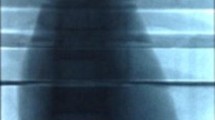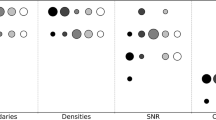Abstract
Background
Many image-intensifier fluoroscopy systems have been replaced by flat-panel detectors in recent years.
Objective
To compare the level of contrast, image resolution and radiation dose between an image-intensifier and a newer-generation flat-panel detector system in a pediatric radiology unit.
Materials and methods
We compared two systems — a conventional image intensifier and a newer-generation flat-panel system. We measured image quality and radiation dose using a technical phantom. Additionally, we retrospectively compared age-matched fluoroscopic pediatric voiding cystourethrography (n = 15) and upper gastrointestinal investigations (n = 25).
Results
In phantom studies image contrast was equal while image resolution was higher and mean radiation dose lower using the flat-panel system (P < 0.0001). In pediatric investigations, mean dose area product was significantly reduced on the flat-panel system for upper gastrointestinal investigation (45 ± 38 μGy*m2 vs. 11 ± 9 μGy*m2; P < 0.0001) and for voiding cystourethrography (18 ± 20 μGy*m2 vs. 10 ± 12 μGy*m2; P = 0.04).
Conclusion
The newer flat-panel system performs at lower dose levels with equal to better image quality and therefore seems to be the more suitable technique for pediatric fluoroscopy in comparison to image-intensifier systems.




Similar content being viewed by others
References
Partridge J, McGahan G, Causton S et al (2006) Radiation dose reduction without compromise of image quality in cardiac angiography and intervention with the use of a flat panel detector without an antiscatter grid. Heart 92:507–510
Seibert JA (2006) Flat-panel detectors: how much better are they? Pediatr Radiol 36:173–181
Hammer GP, Seidenbusch MC, Schneider K et al (2009) A cohort study of childhood cancer incidence after postnatal diagnostic X-ray exposure. Radiat Res 171:504–512
Justino H (2006) The ALARA concept in pediatric cardiac catheterization: techniques and tactics for managing radiation dose. Pediatr Radiol 36:146–153
Darling S, Sammer M, Chapman T et al (2011) Physician documentation of fluoroscopy time in voiding cystourethrography reports correlates with lower fluoroscopy times: a surrogate marker of patient radiation exposure. AJR Am J Roentgenol 196:W777–W780
Malekzadeh M, Bahreyni Toossi MT, Alamdaran SA et al (2012) Comparison between patient dose arising from photofluorographic and standard fluoroscopic voiding cystourethrography in children with urinary tract infection [corrected]. Nephrourol Mon 4:541–544
Nel ED, Ellis A (2012) Swallowing abnormalities in HIV infected children: an important cause of morbidity. BMC Pediatr 12:68
Rommel N, Selleslagh M, Hoffman I et al (2014) Objective assessment of swallow function in children with suspected aspiration using pharyngeal automated impedance manometry. J Pediatr Gastroenterol Nutr 58:789–794
Baijens L, Barikroo A, Pilz W (2013) Intrarater and interrater reliability for measurements in videofluoroscopy of swallowing. Eur J Radiol 82:1683–1695
Hatakeyama Y, Kakeda S, Ohnari N et al (2007) Reduction of radiation dose for cerebral angiography using flat panel detector of direct conversion type: a vascular phantom study. AJNR Am J Neuroradiol 28:645–650
Wiesinger B, Stutz A, Schmehl J et al (2012) Comparison of digital flat-panel detector and conventional angiography machines: evaluation of stent detection rates, visibility scores, and dose-area products. AJR Am J Roentgenol 198:946–954
Miraglia R, Maruzzelli L, Tuzzolino F et al (2013) Radiation exposure in biliary procedures performed to manage anastomotic strictures in pediatric liver transplant recipients: comparison between radiation exposure levels using an image intensifier and a flat-panel detector-based system. Cardiovasc Intervent Radiol 36:1670–1676
Miraglia R, Maruzzelli L, Cortis K et al (2015) Comparison between radiation exposure levels using an image intensifier and a flat-panel detector-based system in image-guided central venous catheter placement in children weighing less than 10 kg. Pediatr Radiol 45:235–240
Tsapaki V, Kottou S, Kollaros N et al (2004) Comparison of a conventional and a flat-panel digital system in interventional cardiology procedures. Br J Radiol 77:562–567
Chida K, Inaba Y, Saito H et al (2009) Radiation dose of interventional radiology system using a flat-panel detector. AJR Am J Roentgenol 193:1680–1685
Bogaert E, Bacher K, Lapere R et al (2009) Does digital flat detector technology tip the scale towards better image quality or reduced patient dose in interventional cardiology? Eur J Radiol 72:348–353
Wiesinger B, Kirchner S, Blumenstock G et al (2013) Difference in dose area product between analog image intensifier and digital flat panel detector in peripheral angiography and the effect of BMI. Röfo 185:153–159
Cohen M (2007) Are we doing enough to minimize fluoroscopic radiation exposure in children? Pediatr Radiol 37:1020–1024
Sidhu M, Coley BD, Goske MJ et al (2009) Image Gently, Step Lightly: increasing radiation dose awareness in pediatric interventional radiology. Pediatr Radiol 39:1135–1138
Sidhu M, Goske MJ, Connolly B et al (2010) Image Gently, Step Lightly: promoting radiation safety in pediatric interventional radiology. AJR Am J Roentgenol 195:W299–W301
Schneider K, Krüger-Stollfuss I, Ernst G et al (2001) Paediatric fluoroscopy — a survey of children’s hospitals in Europe. I. Staffing, frequency of fluoroscopic procedures and investigation technique. Pediatr Radiol 31:238–246
Hsi RS, Dearn J, Dean M et al (2013) Effective and organ specific radiation doses from videourodynamics in children. J Urol 190:1364–1369
Riccabona M, Lobo ML, Willi U et al (2014) ESPR uroradiology task force and ESUR Paediatric Work Group — Imaging recommendations in paediatric uroradiology, part VI: childhood renal biopsy and imaging of neonatal and infant genital tract: minutes from the task force session at the annual ESPR Meeting 2012 in Athens on childhood renal biopsy and imaging neonatal genitalia. Pediatr Radiol 44:496–502
Tompane T, Leong CW, Bush R et al (2013) Appropriateness of radiology procedures performed in children with gastrointestinal symptoms and conditions. Clin Gastroenterol Hepatol 12:970–977
Hiorns MP, Ryan MM (2006) Current practice in paediatric videofluoroscopy. Pediatr Radiol 36:911–919
Schneider K, Perlmutter N, Arthur R et al (2000) Micturition cystourethrography in paediatric patients in selected children’s hospitals in Europe: evaluation of fluoroscopy technique, image quality criteria and dose. Radiat Prot Dosim 90:197–201
Hiorns MP, Saini A, Marsden PJ (2006) A review of current local dose-area product levels for paediatric fluoroscopy in a tertiary referral centre compared with national standards. Why are they so different? Br J Radiol 79:326–330
Conflicts of interest
The Institute of Clinical Radiology and Nuclear Medicine Mannheim has research agreements with Siemens Healthcare Sector.
The study received financial funding from Siemens. None of the authors of the study was employee of Siemens. Measurements and data evaluation were not supported by Siemens.
Author information
Authors and Affiliations
Corresponding author
Rights and permissions
About this article
Cite this article
Weis, M., Hagelstein, C., Diehm, T. et al. Comparison of image quality and radiation dose between an image-intensifier system and a newer-generation flat-panel detector system — technical phantom measurements and evaluation of clinical imaging in children. Pediatr Radiol 46, 286–292 (2016). https://doi.org/10.1007/s00247-015-3456-z
Received:
Revised:
Accepted:
Published:
Issue Date:
DOI: https://doi.org/10.1007/s00247-015-3456-z




